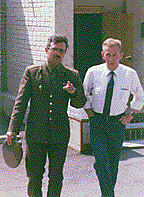| Dismantling
the Soviet INF missile base at Novosysoyevka was typical.
Located near the Sikote-Alin mountain range in the Soviet
province bordering the Pacific Ocean, Novosysoyevka was
an SS-12 base. On July 1, 1988, a train loaded with 14
SS-12 launchers and 4 missile transporter vehicles left
Novosysoyevka station, bound for the elimination site at
Stan'kovo in Belorussia.17
The United States had been notified by official message
through the Soviet NRRC of the time and places of the
7,200-kilometer journey across virtually the entire
Soviet Union. On the same day, another missile train left
the small station at Novosysoyevka, laden with 20 SS-12
missiles. It would arrive, after a trip of 4,200
kilometers, at the Saryozek elimination site in
Kazakhstan. On July 4, a reporter from Sotsialisticheskaya
Industriya visited the Novosysoyevka SS-12 base and
asked Major A. Kostitsyn, the battery commander, about
dismantling the site.18
"Throughout June," Kostitsyn replied, "we
prepared the equipment for dispatch, for it has to cross
the entire country. We missilemen have complex
feelings." He explained his thoughts on dismantling
operational missiles and the pride he had for his nation,
which had negotiated the treaty. However, he also had
concerns about his future. "Our service and life are
changing. It is now my dream to enter an academy. I am a
professional soldier, and I believe that I can still
prove useful to the motherland in that capacity." The remaining 17 SS-12 missiles at the Soviet missile operating base departed Novosysoyevka within a week. The site commander, Colonel Viktor Korshikov, told an Izvestiya reporter that he would remain at the missile base and become the chief site escort. "We are ready for the meeting," he said on July 5, adding, "The Americans will not find the missiles here...."19 The command was prepared, he went on, to show everything stipulated in the treaty. The reporter accompanied Colonel Korshikov into the missile buildings, examining the trucks stored under canopies, looking at the pit machines and track layers. The colonel explained what equipment the American inspectors could examine.20 On October 1, Lt. Colonel Nicholas Troyan, U.S. Army, led an American INF inspection team to the Novosysoyevka SS-12 missile site where they conducted the closeout inspection. The inspection lasted 24 hours on site; however, the logistics needed to get this American inspection team to and from the site illustrated how difficult and arduous these INF inspections could be. In mid-August, Troyan's 10-person inspection team met in Washington, flew to San Francisco and then to Tokyo.21 |
 Soviet Major Igor Kirichenko and Lt. Colonel Nicholas Troyan at Saryozek, USSR. "We are ready for the meeting." Colonel Korshikov |
